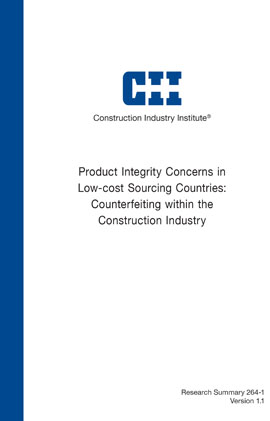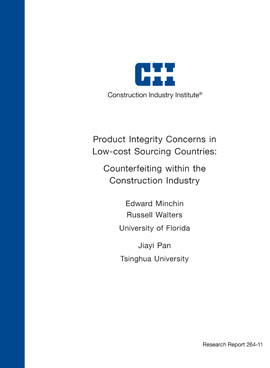
Product Integrity Concerns in Low-cost Sourcing Countries: Counterfeiting within the Construction Industry, Version 1.1
Recent incidents on a project being constructed by a prominent CII member involving the use of counterfeit products has generated an increasing interest in counterfeiting among CII member organizations. To support this industry interest, CII formed Research Team 264 (RT 264) to investigate and provide recommendations on product integrity concerns from low-cost sourcing countries. The team was instructed not to conduct surveys as a data collection method. Due to the sensitive nature of the topic, only data from face-to-face interviews (and a few phone interviews), along with hard photographic and documentary evidence were appropriate for this investigation. Ultimately, the team conducted almost 190 face-to-face interviews with industry and government leaders in the People’s Republic of China, Taiwan, Hong Kong, the United Kingdom, Pakistan, Canada, and the United States.
The team’s focus was on the production of knock-off branded industrial materials and equipment that appear genuine in every way, but that are produced without regard to performance integrity. The team also investigated the production of non-branded raw materials or commodity items that have been deliberately (and often toxically) tainted to produce deceptively favorable test results. One finding was that these materials are sometimes accompanied by fraudulently certified documentation attesting to compliance with specified content or quality. This study into the world of the counterfeiting of non-retail products, uncovered the sophistication of the underhanded tactics that counterfeiters now use to represent their products as genuine.
This study shows that the fundamental need for a controlled supply chain has taken on a new level of criticality. Supplier pre-qualification, manufacturing surveillance, resident inspection, third-party verification, and unscheduled in-process inspections are all activities that all CII member organizations need to diligently perform or procure if they are to maintain supply chain integrity—and thus maintain product integrity.
Product integrity differs from product quality in that product integrity means that the buyer is receiving what the buyer is paying for—not something else of equal quality—but exactly what is paid for. In some situations, a counterfeit item may be of equal or greater quality to the real thing.
The threat of counterfeit products entering the supply chain on construction projects is undeniable and should not be underestimated. It is the intent of this study to forearm CII member organizations with the knowledge they need to thwart this threat and ensuring the safety and reliability of their facilities and processes.
Following are ways for the industry and the individual contractor or owner to fight the problem:
- Maintaining the integrity of the supply chain is the most effective way to combat the problem. Confirm and verify that every link in the supply chain is secure and observed. Responsible manufacturers have designed and implemented highly reliable and secure distribution networks that ensure product integrity. For branded products, trust only manufacturer authorized distributors. The use of brokers, re-sellers, and unauthorized distributors (at any level in the supply chain) are common entry-points for counterfeit products. An immediate supplier could be trustworthy, but could also be a victim of counterfeit entry points up stream. For non-branded products, a holistic approach to the more traditional quality control (QC) techniques discussed below is instrumental.
- The industry as a whole should adopt a zero-tolerance policy regarding counterfeiting. Report all incidences of counterfeiting to the appropriate authorities and never fail to support any law enforcement agency’s effort to prosecute to the full extent of the law.
- Train/educate procurement, quality management, and field personnel on the dangers of counterfeit goods. Teach them how to prevent their entry into the supply chain and to mitigate the damage they do if they are already present.
- Train/educate customs officials and other law enforcement agency personnel regarding measures against counterfeit construction goods and materials—not just the higher-profile retail products.
- Establish more stringent supply chain management activities such as enhanced supplier pre-qualification, more diligent sourcing practices, manufacturing surveillance, resident inspection, third party verification, unscheduled in-process inspections, and any other exercises that will give owners and contractors more confidence in the integrity of the products they’re paying for.
- Use effective positive materials identification (PMI) processes—or other methods of validation—extensively throughout the supply chain.
- Put more emphasis on documenting the quality and integrity of the sourcing of raw materials and commodity items.
It is not uncommon for businesses to receive high quality goods from sources in China, India, Russia, and Brazil, since being competitive in today’s economy requires companies to purchase or manufacture goods in or from these places. But, obviously, having a supply chain deliver quality most of the time is not good enough. In order to ensure that the supply chain maintains both product quality and product integrity, a purchaser must exert unwavering diligence. Moreover, greater coordination among governments worldwide would help immensely.
- Class A – Goods produced by means of patent piracy; high-end goods that are as close as possible to real merchandise.
- Class B – Goods that look nearly identical to genuine product, but that possess sub-standard internal components and may cause catastrophic failures; products that consumers would normally least suspect; deficiencies would not normally be detected by typical quality assurance systems.
- Class C – Obvious junk; poor quality goods that are easy to spot.
- Training and education of supply chain personnel on the hazards of counterfeit goods and how to prevent and mitigate the damage from counterfeit items in the supply chain
- Organizations need to develop and adhere to a qualified supplier program
- Create a testing and inspection program for receipt of products and goods
- Adopt a zero tolerance policy regarding counterfeiting


